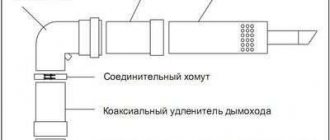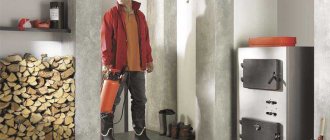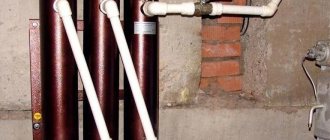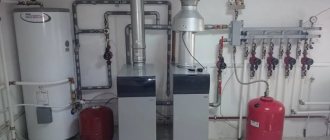.
The main role of the ventilation system is to ensure high-quality air exchange in a room, building or in a certain area. Various options are used to ensure ventilation of buildings. Ventilation of the boiler room is also important.
To dispose of harmful gaseous substances in the boiler room, it is necessary to install ventilation.
In a room of this type, such as a boiler room, a vacuum is created in the air space, which can lead to reverse draft. Therefore, the ventilation device plays an important role among the equipment in a gas boiler room, since it utilizes harmful gaseous substances.
Requirements for ventilation of a gas boiler room
Small capacity boilers (up to 60 kW) are located in the kitchen, provided it meets certain requirements:
- room dimensions of at least 7.5 m3 when installing one heating device, and at least 13.5 when installing two;
- the ceiling is at least 2 m when installing one heating device, and at least 2.5 when installing two;
- glass area in windows is at least 3 cm2 per 1 m³ of room;
- mandatory presence of frames and vents in windows;
- the distance between the heating device and the wall structure is at least 100 mm;
- the wall is covered with fire-resistant material;
- supply of fresh air naturally (through the lower gaps in the doors or special holes in the wall).
For more efficient boilers over 30 kW, a separate room with an area of more than 15 m2 is required.
Features of chimney construction
Proper arrangement of the ventilation system in a boiler room with gas equipment cannot occur without a chimney. It must meet the following requirements:
- The chimney must protect the room from dust, fumes and dirt. Care should be taken to ensure maximum tightness of the pipe itself. For this purpose, a two-layer chimney technology made of a metal box and an asbestos-cement pipe is used.
- The height of the street part of the chimney should be located above the maximum point of the roof. The minimum distance from the roof ridge is 2 m.
- The diameter of the ventilation shaft of the house is made larger than the size of the exhaust pipe of the boiler itself. Each type of equipment has its own calculation standards.
If you decide to build a chimney with your own hands, you should use the rules of SNiP.
This is especially true for the required diameter of the exhaust system. For gas boilers whose power does not exceed 30 kW, it is advisable to use a pipe up to 130 mm. If the boiler is 40 kW - 175 mm, and with 55 kW - 195 mm. If the equipment power exceeds 80 kW, it is important to install a pipe with a diameter of 230 mm.
Other features are also important for building ventilation with your own hands. When choosing a design for a chimney, sheet steel is the best option. Stainless steel or galvanized sheets are suitable. The structure itself should be simple without obstacles, its thickness should be equal in any part of it, and an inspection window should be made on the side of the boiler room.
Requirements for ventilation of a solid fuel boiler and room
The main conditions for ventilation in a boiler room in a private house are compliance with a certain area and volume. This is caused by the required frequency of air exchange per unit of time, fire safety and regular inspections of equipment. Therefore, for normal ventilation of the boiler room, the distance of the boiler from the walls and free access to it must be ensured depending on the performance of the unit:
- For a boiler with a capacity of up to 30 kW, at least 3.5 m2.
- For a thermal device from 30 to 60 kW – 5 m2.
- If the unit has a power of more than 60 kW, then the boiler room area is over 6 m2.
In addition, the height to the ceiling should be 2.2 m.
Why is it needed?
Proper ventilation is an important factor that affects the indoor microclimate. If it is regularly ventilated, the risk of mold and mildew on the walls and ceiling is significantly reduced. There is a low probability of allergic reactions, asthma, and other diseases in people who spend most of their time in such a room (live or work in it).
It is especially important to organize proper ventilation with an influx of fresh air in those rooms where it is not possible to open windows for ventilation or in those not equipped with windows at all, in apartments and offices with plastic windows (how to arrange fresh air ventilation with your own hands?).
Chimney outlet of a heating device in a private house
Chimneys and their installation require a specialized approach and compliance with certain requirements. The walls of the chimney are usually made resistant to temperature changes, corrosion and chemical compounds.
The hood for boilers in a private house must meet building regulations:
- SNiP 41-01-2003 “Ventilation and heating of residential premises.”
- SNiP 42-01-2002, 42-101-2003 “Recommendations and requirements for gas distribution complexes”
Thus, while maintaining these legislations, it is necessary to ensure that smoke removal corresponds to the required air exchange and air safety. And to do this you need to calculate the height and cross-section of the chimney and air duct. During installation, the following conditions must be observed:
- the pipe must be positioned strictly vertically;
- rise above the roof ridge no more than 0.5 m;
- the total height of the vein channel is no more than 5 m;
- The joints in the channel are insulated with heat-resistant sealant.
If the above requirements are met, you can install the ventilation pipe for the heating device yourself.
How to choose material for the hood
To solve such problems, brick, stainless, galvanized steel or ceramic material is used. Let's analyze each of them in more detail.
Coaxial ventilation
This gas boiler hood in a private house consists of a short outer and a long inner pipe. In addition, it includes all sorts of accessories: clamps, elbows, gaskets, as well as a condensate receiver. This design is also called “pipe in pipe” and is used in gas heating appliances with a closed combustion chamber.
The design and principle of operation are the same for all boilers of this type:
- The pipe located inside is connected on one side to the boiler pipe, and its other side is led out to the street and combustion products exit through it. It is made of stainless steel and can withstand high temperature changes.
- The pipe, located outside, is connected at one end to the inlet, and the other end is taken outside the room. Fresh air enters through this channel.
- During operation of the unit, the exhaust combustion products are discharged outside due to draft through the internal channel, and at the same time fresh air is supplied to the combustion chamber through the external channel.
This coaxial device has the following advantages:
- The chimney is safe. This is possible because the escaping hot combustion products are immediately cooled by cold air coming from outside.
- Increased productivity. Fresh air heats up when supplied and increases the efficiency of the unit.
- Environmental friendliness of the system.
- Installation in the kitchen. Such a wall-mounted heating device does not spoil the overall interior of the room.
Another feature of installing such boilers with coaxial air circulation is that in a private home, the chimney can be installed both vertically and horizontally.
Brickwork
Nowadays brick is used less and less for ventilation shafts.
This is caused by two main reasons:
Firstly , due to its fragility, after 7-10 years the brick begins to crumble, and the masonry loses its tightness, which means it loses its purpose. It is destroyed due to the fact that the temperature in the channel changes and as a result condensation forms, which freezes in winter. It is more acceptable to make chimneys from this material when the walls are constantly in contact with hot waste.
Secondly , brickwork is a labor-intensive process; such a ventilation duct has a complex design and unjustified costs.
In this regard, a better option would be a brick shaft with a galvanized pipe inside for ventilation. It is assembled in parts from 2-meter contours, and the thickness of the walls is selected taking into account the temperature of the exhaust gases.
Steel hood
The exhaust gas during operation of a gas boiler has a temperature of about 430 degrees, and even more when operating solid fuel boilers. Therefore, the exhaust pipes for a gas boiler in a private house are made of stainless steel with a wall thickness of 0.7-1 mm. These products are quite stable to the action of condensation on the surface of the walls.
It should be noted that the service life of these ventilation pipes is significantly shorter than that of brick and ceramic ones. At the same time, standard steel hoods are easier to replace because they are lighter and do not require specialized foundations to provide strength.
Such channels are manufactured in different versions:
- Placement in a specially laid brick well;
- From factory circuits. In this case, each circuit is a sandwich pipe with two walls. Here one pipe is located inside another, and the gap is filled with heat-insulating material.
The use of such hoods simplifies installation, and they can be mounted both indoors and outdoors.
Ceramic hood
It should be appreciated that a ceramic channel is an ideal solution for all types of boilers in a private home. This material is resistant to high temperatures. It is also neutral towards toxic chemical compounds that can be formed during the combustion of various fuels. Ceramic hood channels are mainly arranged vertically in modules with one or two recesses.
In the latter version, the second channel is used to ventilate the boiler room or to supply air to the boiler burner. Typically, such sandwiches are insulated with mineral wool to protect them from cooling and condensation. In addition, natural draft increases in an insulated pipe. When installing such a ceramic hood, there must be a gap for free passage of air between the insulation and the surface of the well.
On the building materials market you can find sets of ceramic hoods in a metal casing. This model does not require ventilation gaps and is mounted on a heating device both inside and outside the house. They can be operated with exhaust gas temperatures up to 450 degrees.
At the same time, ceramics absorb moisture well, so they usually have a tray to collect condensed moisture. And the channel itself is provided with free access for airflow. Thanks to the smooth surface in the pipe, it is resistant to contamination and easy to clean during maintenance.
To operate solid fuel boilers in a private home, pipes are used that can withstand temperatures of 650 degrees. In addition, they must be neutral to soot combustion and operated in a dry condition.
Tips for use
For normal operation, clean and inspect it before each heating season. It is possible to replace some parts and elements. Deterioration in functioning is associated with a decrease in the useful diameter of pipes and the emergence of new air routes. For example, through open doors and windows.
Natural systems fail under strong winds and sudden pressure changes. Another reason is the difference in temperature outside and in the extension. Therefore, they need to be compensated by compulsory devices. Check for normal rotation speed of the impeller. The first sign of a malfunction is the appearance of noise.
Incorrect operation of air exchange leads to a decrease in heating efficiency and interruptions. This may be one of the failure factors. Check for tightness and absence of dirt and debris.
Calculation of the ventilation system
It is recommended to calculate ventilation in a room with a gas boiler, taking into account the following parameters:
- boiler room volume;
- air mass speed;
- air exchange rate;
- number of family members.
Taking these parameters into account, the required exhaust cross-section for a gas boiler is calculated, while there is no need to calculate the diameter of the inlet opening, since these dimensions must be equal. If the boiler room already exists, but the diameter of the exhaust duct is less than the calculated one, additional forced ventilation must be done. You can use different methods for calculation, two of them are given below.
Calculation of ventilation based on the number of air exchanges:
L = N × S × N, where:
L—boiler power kW/h;
N is the air renewal rate;
S—boiler room area;
H - height to ceiling in m.
Calculation of ventilation by number of family members:
L = N × Lн, where:
L—boiler power kW/h;
N is the number of family members in the house;
Lн - minimum air consumption per person:
during rest - 20 m³/h;
with passive activity - 40 m³/h;
during physical activity - 60 m³/h
Selection and installation of equipment
Natural air exchange in the boiler room is achieved through supply and exhaust ducts.
When installing the supply duct you must:
- Prepare a piece of plastic pipe, filter mesh and check valve. The cross-section of the pipe is selected depending on the power of the boiler. In the case where the productivity is less than 30 kW, then 150 mm is enough. The greater the power, the larger the cross-section.
- To create the correct combustion process and appropriate exhaust in a private house, the air supply must be created as close as possible to the boiler firebox. Therefore, a hole in the wall must be punched opposite the burner, but not above its working area. A piece of pipe is inserted into the hole, and the cracks are sealed with foam.
- The outside of the pipe is covered with a mesh to protect it from insects and small animals. A check valve must be installed inside the pipe to protect against backdraft to the street.
- Exhaust pipes in the boiler room with natural ventilation are installed only vertically, and their height should not be less than 3.5 m.
Nowadays, many users do not question the choice of one or another supply ventilation, since the optimal solution would be to install a combined air exchange system.











